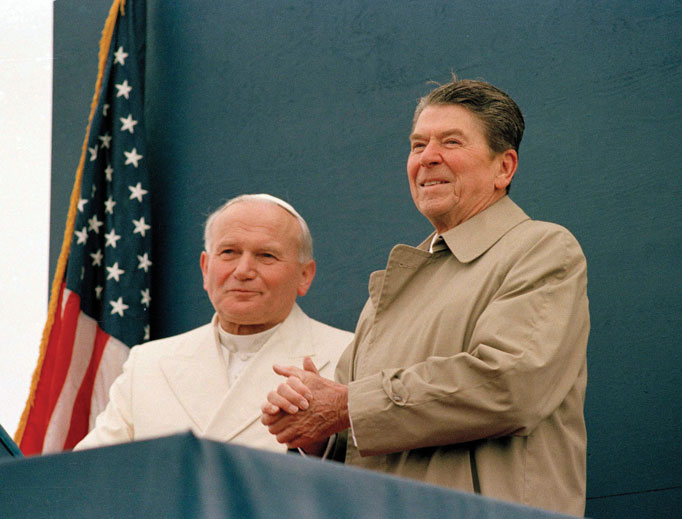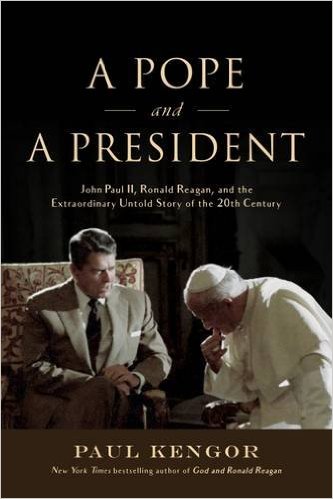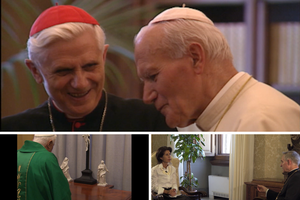How a Saint and a President Defeated Communism
Author Paul Kengor discusses A Pope and a President.

|
A Pope and a President: John Paul II, Ronald Reagan, and the Extraordinary Untold Story of the 20th Century is the latest book from New York Times best-selling author and Register contributor Paul Kengor. A political historian and Reagan biographer, Kengor tells the story of the providential partnership and shared vision of St. John Paul II and Reagan to meet and challenge communism head-on. |
The new book hit stores May 1. The Register recently interviewed Kengor via email.
What prompted you to write A Pope and a President?

I’ve been writing this book for years. I’ve written literally over a dozen books since I started the research for this one. I started filing FOIA (Freedom of Information Act) requests to declassify documents related to the Reagan-John Paul II relationship back in 2000.
I went through countless documents at the Reagan Library and in various archives, such as the Soviet Comintern and Central Committee archives. I read through numerous letters, transcripts, cables, editions of Pravda, Izvestia, and on and on. This is the longest book I’ve written because the story is so deep.
The vicious war on the Church by atheistic communism is so horrific and massive that I didn’t know where to stop exposing it.
I think readers will encounter the same struggle I had in writing this book: You can’t pull yourself away because of the characters involved and the battle of good versus evil involved.
To that end, a warning to readers: Just as you’ll be heartened by what you read, you’ll also be sickened. The heartening part is the great good done by John Paul II and Ronald Reagan. The sickening part is the colossal evil perpetrated by malicious atheistic communism. These two men waged battle against the beast. They carried the cross.
Why do you see it as the “Extraordinary Untold Story of the 20th Century?”
The story of the 20th century was the battle against atheistic communism that began in Bolshevik Russia in October 1917 and was warned about by Our Lady in Fatima. That was an epic struggle running from 1917 until about 1989-91, far outlasting the shorter-term fight against Nazism, which both Karol Wojtyla and Ronald Reagan also engaged. When that century-long conflict was finally won — peacefully — it was done so by Pope John Paul II and Ronald Reagan. They fought that monster their entire adult lives. The way they did so, including as partners, and everything that happened amid the long road in between, is truly the extraordinary untold story of the 20th century.
St. John Paul II would attribute his survival to the miraculous intervention of the Blessed Mother, Our Lady of Fatima. Was there any spiritual bond between him and Reagan?
Both men survived assassination attempts mere weeks apart in March and May 1981. When they finally came together in June 1982, they spoke of the “miraculous” fact that they both survived. Both understood that they should have bled to death on their respective routes to the hospital. They both believed — and said to one another — that God had spared them for a special purpose. The purpose was to work together to bring down atheistic Soviet communism and free people behind the Iron Curtain.
Did you find Reagan having any interest in Fatima?
That’s one of the most intriguing things I found. That’s one of two aspects of this book that will most surprise Catholics.
The first, for the record, is that I confirmed that the Soviets did order the shooting of the Holy Father and (this is totally new) that Ronald Reagan and his top advisers — most notably, two devout Irish Catholics, Bill Casey and Bill Clark — all along suspected the Soviet role and would privately conclude that Moscow was involved. That conclusion was based on a super-secret CIA report that has never been made public.
My book doesn’t present the actual report, but it does disclose for the first time the existence of such a report/investigation and of its confirmation of a Soviet hand. The conclusion was that Moscow, working not through the Soviet KGB, but through the Soviet GRU (military intelligence), ordered the attempted assassination: The Soviet communists, ladies and gentlemen, tried to murder a pope.
As for John Paul II, he always suspected a Soviet hand, especially in July 1981, upon reading the Third Secret of Fatima after recovering from his wounds — atop the fascinating reality that he was shot on the feast day of Our Lady of Fatima. When he read the Third Secret, which had predicted an attack on a future pope among the “errors” of Russian communism, it essentially affirmed for him that the Soviets were involved. Any doubts were wiped away when he opened the envelope. The second aspect of the book that will most surprise Catholics was Ronald Reagan’s intense interest in Fatima. No one knows about this. I was fascinated by it. I detail it at great length.
How did you learn about it?
I learned about it via a ton of research and interviews with people who worked directly with Reagan, including a person who briefed him on Fatima prior to his second one-on-one meeting with John Paul II in Rome in June 1987.
When Reagan went to Portugal in 1985, did he bring out any connections to Fatima and to John Paul II?
He did. And I’m amazed that we Catholics don’t know about this. Of course, it got absolutely no publicity, so our ignorance is understandable.
Ronald Reagan gave a speech in Portugal in May 1985 where he openly mentioned Mary and the children of Fatima. He spoke of the “great religious shrine” at Fatima and said that when he met Pope John Paul II he “dared to suggest to him that, in the example of men like himself and in the prayers of simple people everywhere, simple people like the children of Fatima, there resides more power than in all the great armies and statesmen of the world.”
That’s just the start of what I mention in this book about Reagan and Fatima and the Blessed Mother.
Here’s another shocker for Catholics: Reagan was intrigued by the reported appearances of Mary in Medjugorje. I was taken aback when Ave Maria was sung at Reagan’s memorial service in the Washington Cathedral in June 2004. That was the last hymn I expected to hear at his funeral. Mrs. Reagan told me that Ronald Reagan himself had chosen Ave Maria to be sung at that funeral, years before Alzheimer’s had taken him.
Now, looking back in retrospect, I’m not surprised.
Did you find any other fascinating Fatima connections to these events that you detail in the book?
Fatima is the thread throughout the book, from start to finish. I open with the shooting of John Paul II in St. Peter’s Square on May 13, 1981, the feast day of Our Lady of Fatima. That’s the prologue. Then, in Chapter 1, I bounce back to May 13, 1917, when Mary first appeared to Lucia, Jacinta and Francisco. That starts the narrative. Thereafter, the book is a story, a chronological narrative, that winds through the rise of Bolshevism and the Soviet war on religion — as the Lady had predicted — and then the births and rise of Ronald Reagan and Karol Wojtyla.
Amid their rise, the narrative is interspersed with painful examples of communist persecution of the faithful, done to the likes of Cardinals Mindszenty and Stepinac to Popes Pius XII and John Paul II.
I even take into account the communist ideology behind the assassins of leading American Catholic politicians such as John Kennedy and Robert Kennedy. Throughout that sad saga I incorporate the brilliant insights of the most influential American Catholic of the 20th century: Fulton Sheen. Sheen may be the most prominent figure in this book after Reagan, John Paul II and the Blessed Mother.
What a prophet Sheen was. And he just happened to have been raised just down the road from Ronald Reagan. The book considers many intriguing Reagan-Sheen parallels. That’s yet another of so many rich Reagan-Catholic connections that will stun and please Catholics.
Joseph Pronechen is a
Register staff writer.

















